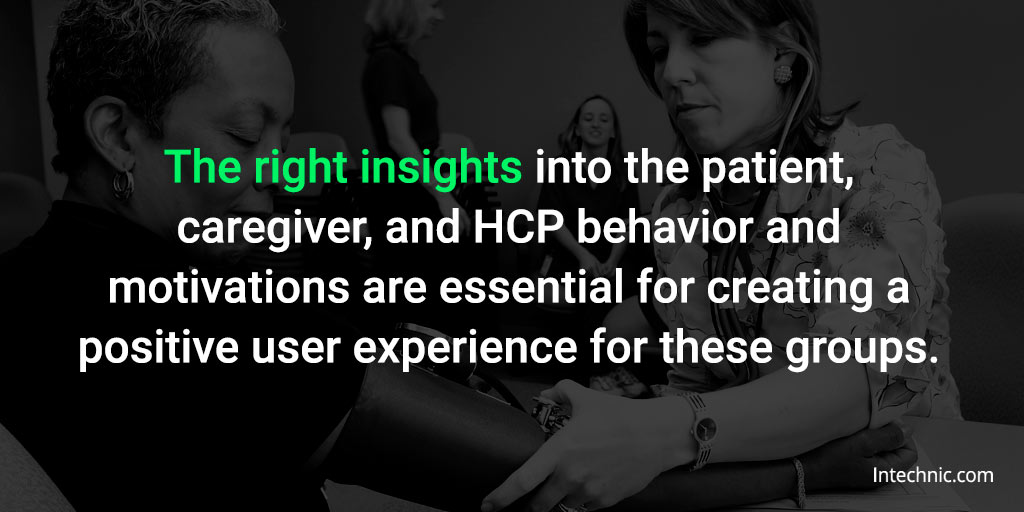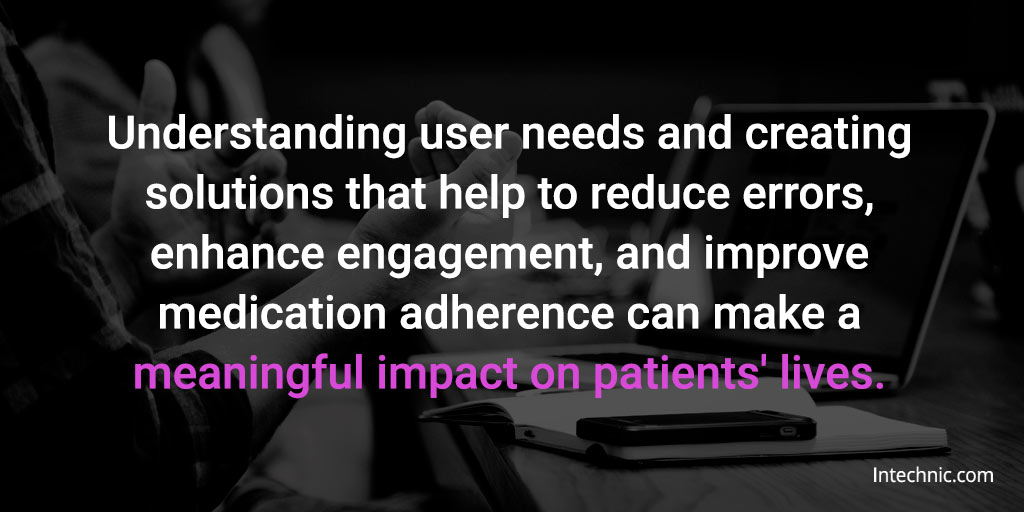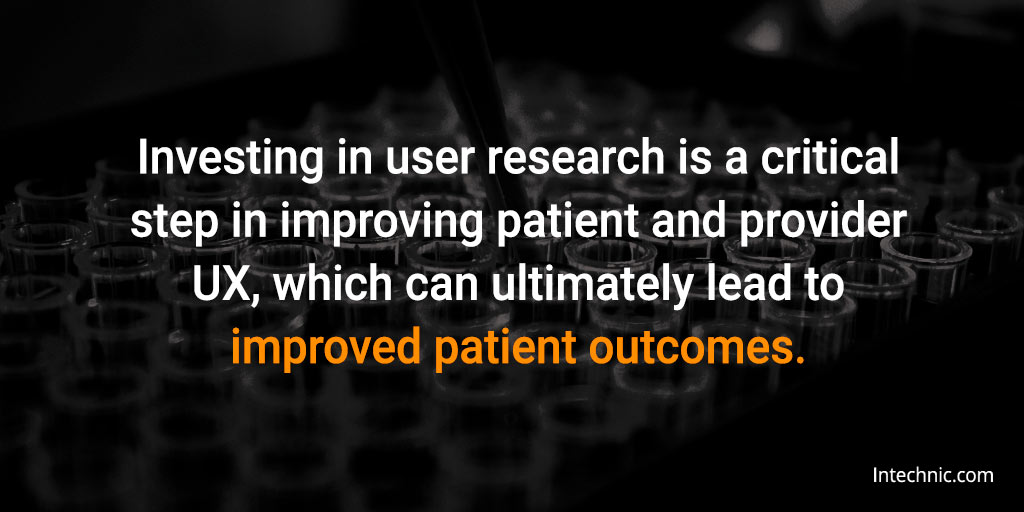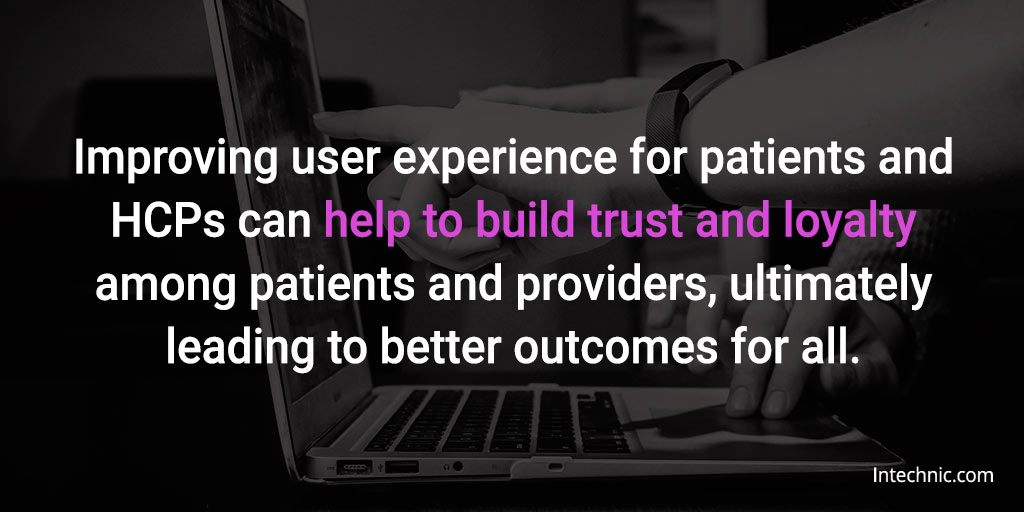User research is a crucial part of the user experience (UX) design process, as it involves gathering insights and understanding the needs, motivations, behaviors, and attitudes of the target users of a product or service.
User research is even more essential when designing websites and digital products in the healthcare and pharmaceutical industries. A recent study revealed that only 27% of pharma digital teams always conduct user research when developing digital products.1 Yet, healthcare providers (HCPs), caregivers, and especially patients have unique needs and expectations, and creating a positive user experience for these groups can be more challenging without having the right insights into their behavior and motivations.

What is user research?
User research refers to the process of gathering insights and data about users' behaviors, needs, and preferences to inform the design of products, services, or interfaces. User research is a critical aspect of the UX design process, as it helps to understand the target users' expectations, as well as how they interact with the product being designed. This understanding enables designers to create effective solutions that are user-centered, intuitive, and meet the users' needs.
User research methods can vary based on the goals of the research and the type of data being collected. Some common user research methods include:
- Interviews: One-on-one discussions with users to gather qualitative data on their experiences, behaviors, and attitudes towards a product or service.
- Surveys: Questionnaires that gather quantitative data on users' opinions, attitudes, and behaviors.
- Focus groups: Group discussions with multiple users to gather qualitative data on their experiences and opinions about a product or service.
- Usability testing: Observing users as they interact with a product or service to identify usability issues and collect feedback.
- A/B testing: Testing two versions of a product or service to determine which version is more effective based on user behavior.

User research is a critical aspect of the design process as it helps designers create solutions that meet the needs and expectations of their target users. By conducting user research, designers can:
- Identify pain points and opportunities: User research enables designers to identify areas where users are struggling or where there is room for improvement in a product or service.
- Understand user behavior: User research provides designers with insights into how users interact with a product or service, which enables them to design effective solutions that are intuitive and easy to use.
- Validate or refute assumptions: User research can help designers validate their assumptions about user behavior and preferences, which can lead to better-informed design decisions.
- Increase user satisfaction: By creating user-centered solutions, designers can improve user satisfaction and engagement with a product or service, ultimately leading to better outcomes.

Why is user research important for pharma and healthcare UX?
User research is an essential part of creating effective and safe products and services in the pharma and healthcare industries. Better understanding of user needs can help designers create solutions that lead to reduced errors, enhanced engagement, improved treatment adherence, ultimately improving health outcomes and making a meaningful impact on patients' lives.
- Understanding users’ needs: In the pharma and healthcare industries, understanding the user's needs is critical to creating effective and user-centered products and services. User research enables designers to gain insights into patients' and HCPs' experiences, behaviors, and preferences, which can help to inform the design of products and services that meet their needs and provide empathetic user experience.
- Reducing errors and increasing safety: User research can also help to reduce errors and increase safety when it comes to pharma and healthcare digital products. Conducting user research enables designers to identify potential risks and issues with products and services and develop solutions that minimize the risk of errors and improve patient safety.
- Enhancing patient engagement: User research can also help to enhance patient engagement with healthcare products and services. Understanding patients' needs and preferences helps to create solutions that clearly provide value and benefits to patients, which can lead to better patient engagement and ultimately better outcomes.
- Improving treatment adherence: Adherence to treatment is critical for achieving positive health outcomes, and user research can help designers to identify barriers and develop solutions that promote adherence.
- Promote health equity and inclusion: Testing with a diverse group of real users is essential to ensure that digital healthcare tools are inclusive and promote health equity.
- Improving patient outcomes: Ultimately, user research is critical for improving patient outcomes in the pharma and healthcare industries. Creating user-centered solutions that meet patients' needs, promote adherence, and enhance engagement enables designers to help to improve patient outcomes and quality of life.
How to conduct user research for pharma and healthcare UX design
Conducting user research for pharma and healthcare UX involves identifying the target audience, selecting the appropriate research methods, recruiting participants, conducting research, analyzing data, and reporting findings. By following these steps, designers can gain insights into the target audience's needs, behaviors, and preferences, and create solutions that meet their needs.
- Identifying the target audience: The first step in conducting user research is to identify the target audience. This involves identifying the right population of patients, healthcare professionals, or other stakeholders who will be using the product or service being designed.
- Selecting the appropriate research methods: Once the target audience has been identified, the next step is to select the appropriate research methods. There are a variety of research methods that can be used in healthcare UX research, including interviews, surveys, focus groups, usability testing, and A/B testing. The research methods selected should be based on the research goals, the type of data being collected, and the resources available.
- Recruiting participants: After selecting the appropriate research methods, participants need to be recruited. Depending on the research method, participants may be recruited from healthcare facilities, patient support groups, or online communities. It is important to ensure that the participants are representative of the target audience being studied.
- Conducting research: Once participants have been recruited, research can be performed. This may involve conducting interviews, surveys, or usability testing. It is important to ensure that the research is performed in a neutral and non-biased way to obtain accurate and useful data.
- Analyzing data: After the research has been conducted, the data needs to be analyzed. It may include identifying patterns or themes in the data, coding responses, and using statistical analysis to identify trends. The goal of data analysis is to gain insights into the target audience's needs, behaviors, preferences, and pain points.
- Reporting findings: Finally, the findings need to be reported. This may involve creating a report, presentation, or other communication to share the research findings with stakeholders. The report should include a summary of the research goals, the methods used, the findings, and recommendations for improving the product or service being designed.

Challenges of conducting user research in pharma and healthcare
Conducting user research in healthcare and pharma presents a unique set of challenges, including ethical considerations, legal barriers, and time and budget constraints, among others. To overcome these challenges, designers must be creative and flexible in their research methods and collaborate closely with stakeholders to ensure that research is performed in a responsible and effective manner.
- Regulatory considerations: One of the main challenges of conducting user research for healthcare is navigating regulatory and ethical considerations. The healthcare and pharmaceutical industries are highly regulated, and there are strict guidelines around the collection and use of patient data as well as around what information needs to be displayed. Designers must ensure that their research methods are ethical and follow all regulatory standards and that they obtain informed consent from participants.
- Legal barriers: In addition to ethical considerations, there may be legal barriers to conducting user research in pharma and healthcare UX. For example, the use of certain research methods may be restricted by laws and regulations, or there may be limitations on the use of patient data.
- Recruiting participants: Recruiting participants for user research in healthcare and pharma can also present a challenge. Patients may be reluctant to participate due to concerns about privacy or the sensitive nature of their health information. Healthcare professionals may be difficult to recruit due to their busy schedules and workloads.
- Time and budget constraints: Finally, time and budget constraints can be a significant challenge in conducting user research. Research in the healthcare industry can be time-consuming and costly, particularly when working with patients or healthcare professionals. Designers must balance the need for thorough research with the practical limitations of time and budget.

Investing in user research is a critical step for pharma and healthcare companies in improving patient and provider UX, which can ultimately lead to better patient centricity improved patient outcomes. By gaining insights into the needs and preferences of patients and healthcare professionals, companies can create solutions that are more effective, safe, and engaging. This can help to build trust and loyalty among patients and providers, ultimately leading to better health outcomes for all.
Not sure where to start?
At Intechnic, we have over 25 years of UX research experience in healthcare and pharma. We’re available for a no-obligation evaluation of your website and for a discussion of your digital goals and challenges to determine which course of action is best for you.
References
- PMLiVE. Demonstrating the value of UX research in pharma and healthcare. December 2022.


